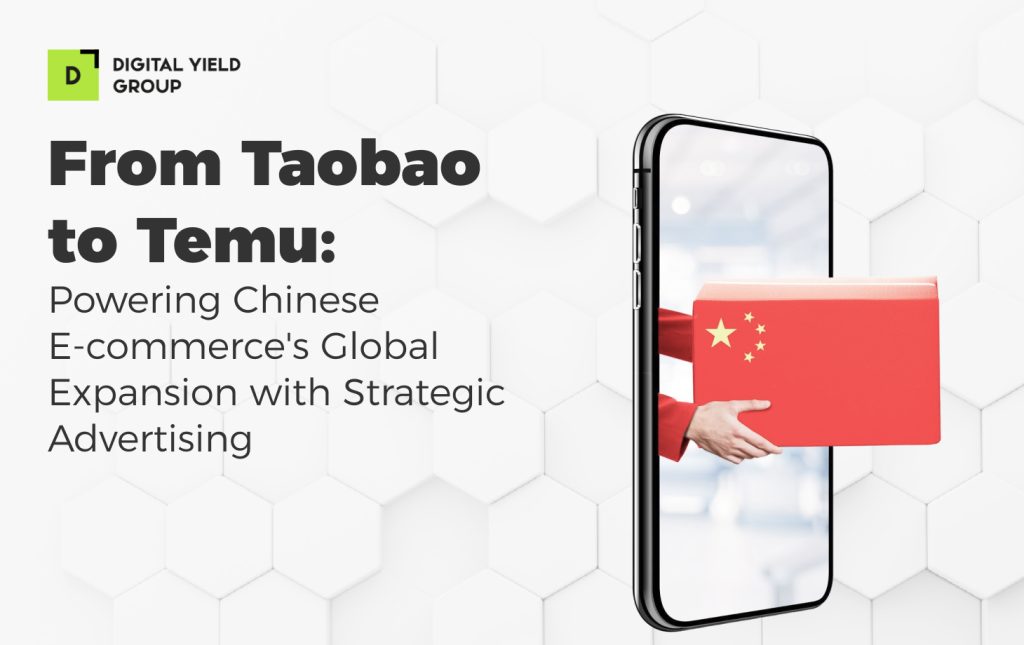From Taobao to Temu: Powering Chinese E-commerce’s Global Expansion with Strategic Advertising

Chinese e-commerce is rewriting the rules of global retail. What started with platforms like Taobao serving local shoppers has exploded into a worldwide phenomenon. Since 2015, fueled by a mobile-first culture and relentless innovation, Chinese platforms have gone from regional players to global powerhouses. Today, names like Temu, Shein, and AliExpress are outpacing legacy retailers across continents, offering unbeatable prices, aggressive advertising, lightning-fast logistics, and a shopping experience built for the swipe-and-scroll generation.
I. Strategic Advertising Approaches Fueling Global Expansion
Chinese e-commerce platforms have mastered sophisticated advertising strategies that go beyond traditional marketing, leaning into mobile user behavior and technological innovation to drive global user acquisition.
Temu is a clear example. It’s been one of the most aggressive digital advertisers, especially across Meta and Google. In 2023, it reportedly spent $3 billion on marketing, $2 billion of that on Meta alone. When Temu pulled back on ads in May 2025, U.S. sales dropped sharply, highlighting the clear connection between ad spend and growth.
AliExpress leans on performance marketing too, including competitive pricing and frequent promotional events, such as its annual 11.11 Global Shopping Festival. Its strategy blends price-based promotions with tools that track and optimize results across social channels and advertising networks.
The Mobile User Focus: Statistics and Engagement
The success of these is closely tied to how well they engage mobile users. Their designs, content, and ad strategies are all built with mobile behavior in mind.
- A Mobile-First Model:
Everything about these platforms from app investments to video content and ad strategies points to mobile as the dominant focus. Nearly 90% of consumers watch short-form videos on their phones daily; this trend plays directly into the strengths of Chinese e-commerce platforms, which are optimized for vertical video, fast scrolling, and impulse purchases. The way users engage (on commutes, breaks, or while scrolling TikTok) reinforces this mobile-first reality. Local mobile DSPs and ad exchanges are playing a key supporting role here, helping Chinese eCommerce brands tailor video campaigns to regional behaviors, and win new markets efficiently.
- CTV as a Growth Channel:
Connected TV (CTV) is also emerging as a strong user acquisition channel, especially in markets where mobile channels are crowded. CTV combines broad reach with precise targeting, helping Chinese mCommerce brands reach mobile-first audiences on a bigger screen, often at a lower acquisition cost.
- App Downloads and Engagement:
Shein’s app was downloaded 261.9 million times in 2023 and 199.4 million more in 2024 (as of October), consistently ranking among the world’s most-used shopping apps. Temu saw 47.7 million downloads in January 2024 and another 41.3 million in March, reaching over 484 million in total by October. And people aren’t just downloading the apps, they’re spending time using them daily: Temu users spend an average of 22 minutes, compared to about 11 minutes on Amazon and 12 minutes on Shein.
II. The Road Ahead: Challenges, and Evolving Strategies
Despite their growth, Chinese e-commerce platforms face mounting challenges — particularly around regulation and geopolitics.
In the U.S., new tariffs are creating headwinds. The removal of the “de minimis” exemption means more packages are now taxed, some with tariffs of 30% to 54%, and others with a flat $100 fee. This change hit hard: Temu’s U.S. sales fell 25% between May and June 2025, while Shein saw a 20% year-over-year drop.
In response, both Temu and Shein are strategically shifting their focus towards European markets, where import fees are currently lower and growth has been robust. However, Europe is also tightening regulations, with proposed new customs fees and ongoing consumer law probes. France, for instance, has passed legislation imposing taxes (up to €10 per item by 2030) and banning fast fashion advertisements, indicating a growing regulatory pushback.
To adapt, platforms are optimizing their supply chains, expanding fulfillment outside of China, and holding prices low by operating on thin margins. They’re also experimenting with new shipping models and spreading their supplier networks to minimize the impact of any one country’s policies.
As global growth continues, simply translating an app isn’t enough. Long-term success will require real cultural adaptation, tailoring product selection, packaging, and customer experience to fit local expectations. Platforms that can do this well will be better positioned to thrive in diverse, regulation-heavy markets.
III. Conclusion
The rise of Chinese e-commerce, from early platforms like Taobao to global giants like Temu, Shein, and AliExpress, marks one of the most significant transformations in modern retail. What began as a domestic movement is now reshaping how people shop around the world.
At the heart of this success is a deep understanding of mobile consumer behavior and an aggressive, data-driven approach to advertising. These platforms treat media spend not as overhead but as fuel: powering visibility, user acquisition, and market share. Not only Meta and Google, but also local mobile advertising partners have become key enablers of this approach, helping brands navigate fragmented markets, fine-tune campaign performance, and scale with precision across regions. Chinese e-commerce platforms’ ability to adapt quickly, invest strategically, and pivot in response to global pressures shows just how agile and forward-thinking they are. They’re also redefining the line between content, commerce, and community, blending entertainment with shopping, and turning every scroll into a potential purchase.
The road ahead isn’t without obstacles. Tariffs, regulation, and growing scrutiny around sustainability will test their models. But with continued innovation, strategic flexibility, and a focus on the mobile-first global shopper, Chinese e-comm is well positioned for what comes next.


